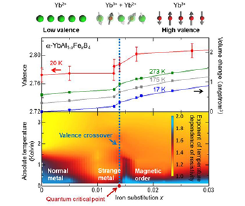Discovery of ‘Quantum’ Supercritical State of an Electron Fluid Induced by Valence Fluctuations
S. Nakatsuji, S. Shin, and T. Sakakibara
The supercritical fluid state near the liquid-gas critical point has been a major subject in condensed matter physics for its technological relevance and for its scientific significance. One of the important goals is to bring down the critical temperature and pressure, which are normally much higher than ambient conditions. By contrast, in the electronic versions of these critical points, there are some cases where the temperature scale may be reduced significantly down to near-zero temperatures so that one may observe quantum critical phenomena in the corresponding “supercritical” states. Strange metal behaviors have been seen in correlated electron systems as a result of proximity to a quantum critical end point of a first-order transition such as a metamagnetic transition and a Mott transition. Another candidate for the density instability that may theoretically drive novel quantum criticality (QC) is valence transition [1]. Near its associated quantum critical end point, singular fluctuations of valence (which includes charge, spin, and orbital degrees of freedom) and its coupling with thermodynamic quantities are expected to lead to a strong violation of Fermi liquid (FL) behavior. Similar to the Widom line in the supercritical fluid [2], fluctuations remain strong near the valence crossover line. Although a valence crossover at low temperatures has been reported in a variety of materials [3, 4], the associated QC has not been confirmed to date.

Fig. 1. Emergent quantum valence supercritical state in α-YbAl1-xFexB4 at x = 0.014 exhibiting the sharp change in the valence, volume and the power law exponent in the temperature dependence of the resistivity.The high valence state and the low valence state are fluctuating around the valence crossover region as illustrated at the top of the figure. Here the arrows indicate the magnetic moments of the Yb3+ ion (red sphere). The middle of the figure shows the sharp valence change at around x = 0.014 at the absolute temperature of 20 Kelvin determined by the hard x-ray photoelectron spectroscopy (HAXPES). Significantly, the volume shows a similar x dependence to the valence. The contour plot at the bottom of the figure highlights the strange metallic state (yellow highlighted regions) emergent concomitantly with the sharp valence crossover at x = 0.014 between the normal metallic and magnetic ordered states. The contour plot indicates the variation of the power law exponent of the temperature dependence of the resistivity. The valence quantum critical point exists at x = 0.014 and at absolute zero temperature.
A valence critical end point existing near the absolute zero provides a unique case for the study of a quantum version of the strong density fluctuation at the Widom line in the supercritical fluids. Although singular charge and orbital dynamics are suggested theoretically to alter the electronic structure significantly, breaking down the standard quasi-particle picture, this has never been confirmed experimentally to date. We provide the first empirical evidence that the proximity to quantum valence criticality leads to a clear breakdown of Fermi liquid behavior. Our detailed study of the mixed valence compound α-YbAlB4 reveals that a small chemical substitution induces a sharp valence crossover, accompanied by a pronounced non–Fermi liquid behavior characterized by a divergent effective mass (Fig. 1) and unusual T/B scaling in the magnetization.
References
- [1] S. Watanabe and K. Miyake, Phys. Rev. Lett. 105, 186403 (2010).
- [2] B. Widom, J. Chem. Phys. 43, 3898 (1965).
- [3] J.-P. Rueff et al., Phys. Rev. Lett. 106, 186405 (2011).
- [4] K. Matsubayashi et al., Phys. Rev. Lett. 114, 086401 (2015).
